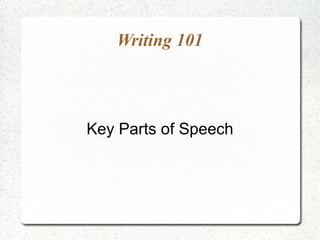
Upper Pri A - Key parts of speech and introduction to phrases
- 1. Writing 101 Key Parts of Speech
- 2. Learning Objectives To understand the roles of words called Parts of Speech in a sentence. To recognise the key Parts of Speech in a sentence.
- 3. Introduction A movie has many people working to make it happen. There are some who play more important roles like the Director, Producer, Main Actor and Actress. The same applies in a sentence too. There are many words but some are more important than others as they provide key ideas.
- 4. Introduction A part of speech describe the job a word does in a sentence. Let's take the simplest sentence for a start: John wept. 'John' is a name and is called a Noun whereas 'wept' is an action and is called a Verb. A Noun and a Verb form a complete sentence. Hence, they are the key words in a sentence as they give key ideas.
- 5. Simple Sentence Simple sentence, as the name implies, is the simplest sentence in English. It only has a Noun and a Verb. 1) David stopped. 2) He shouted. 3) Angel sighed. It is used specially for dramatic or exciting moments in a story. Often, our sentences are longer than that.
- 6. Expanding Simple Sentences Simple sentences – with a Noun and a Verb – can be made longer – or expanded – through the use of 2 other Parts of Speech: Those describing Nouns are called Adjectives. 1) Poor Alex wept. 2) Little Angel sighed. Those describing Verbs are called Adverbs. 1) Alex wept loudly. 2) Angel sighed bitterly.
- 7. 4 Key Parts of Speech Sentences with all 4 key Parts of Speech carry greater meaning: 1) Poor Alex wept loudly. (Adj) (N) (V) (Adv) 2) Little Angel sighed bitterly. (Adj) (N) (V) (Adv) They express more while still keeping your sentences simple.
- 8. 4 Key Parts of Speech Together, Noun, Verb, Adjective and Adverb form the key parts of speech in a sentence. They give the key ideas in a sentence. To help you remember them easily, these 4 key Parts of Speech are called NAVA. N – Noun (name) A – Adjective (describes noun) V – Verb (action) A – Adverb (describes verb)
- 9. Expansion with Phrases Nouns, Verbs, Adjectives and Adverbs can be expanded to become phrases too. Phrases are made up of two or more words that does not express a complete idea like a sentence does. Adjectival Phrases Poor, poor Alex wept. (Compare: 'Poor Alex wept') The little Angel sighed. (Compare: 'Little Angel sighed') Adverbial Phrases Poor Alex wept loudly at night. Little Angel sighed bitterly in the room.
- 10. Learning Activity Identify the 4 Key Parts of Speech (P/S) – NAVA – in the following sentences. 1) Glenda is a very successful violinist locally. 2) Peter hymns his favourite tunes loudly. 3) Raina works diligently in her job. 4) The professional dancers performed often in Esplanade. 5) We need to get moving soon. ● Note: Not all questions have all 4 P/S and some are phrases, such as noun phrase.
- 11. Learning Activity Answers (Part 1) The 4 Key Parts of Speech – NAVA – in the following sentences are: 1) Glenda is a very successful violinist locally. (N) (V) (Adj) (N) (Adv) 2) Peter hymns his favourite tunes loudly. (N) (V) (Adj) (N) (Adv) 3) Raina works diligently in her job. (N) (V) (Adv) (N)
- 12. Learning Activity Answers (Part 2) The 4 Key Parts of Speech – NAVA – in the following sentences are: 1) The professional dancers performed often in Esplanade. (Adj) (N) (V) (Adv) (N) 2) The massive cruise liner need some time to get moving. (Adj) (N Phrase) (V) (Adv. Phrase) (V) (N – Gerunds are Verbal Nouns)
- 13. Discussion What are Parts of Speech and the 4 Key Parts of Speech? Why are they the most important words in a sentence? What can be used to expand sentences besides using all four Key Parts of Speech?
- 14. In Summary Parts of Speech describe the job a word does in a sentence. The 4 key Parts of Speech are Noun, Verb, Adjective and Adverb. They describe the key ideas in a sentence. To expand sentences, phrases can be used, besides using all 4 key Parts of Speech.
